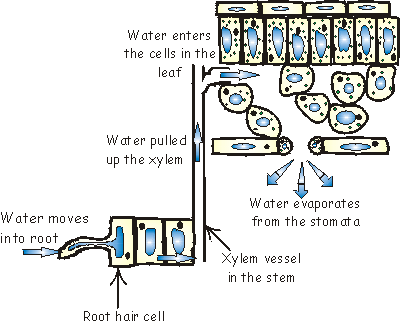The Passage of Water through the Plant
Water enters the plant via the roots. The roots are adapted for this role by having cells with hair-like protrusions (root hair cells) which increases the surface area.
Water enters the root by osmosis and moves along through the root cells in the same way until it gets to the xylem vessels. These vessels carry water up the stem to the leaf.

Water is lost from the leaves of plants by evaporation. This is known as transpiration. Most of the water lost by a plant occurs through the tiny pores in the leaf called stomata. These pores open during the day to allow gaseous exchange for photosynthesis. In doing so they also allow water to be lost by evaporation from the cells of the leaf.
Water is drawn from the xylem vessels in the veins of the leaf by osmosis to replace the water lost. This drawing of water from the xylem vessels causes water to be pulled up the xylem vessels of the stem from the roots.
The xylem vessels themselves are very thin tubes, like capillary tubes. They have very hard and waterproof walls. The cells which made the xylem vessels died to produce a continuous column or tube.
